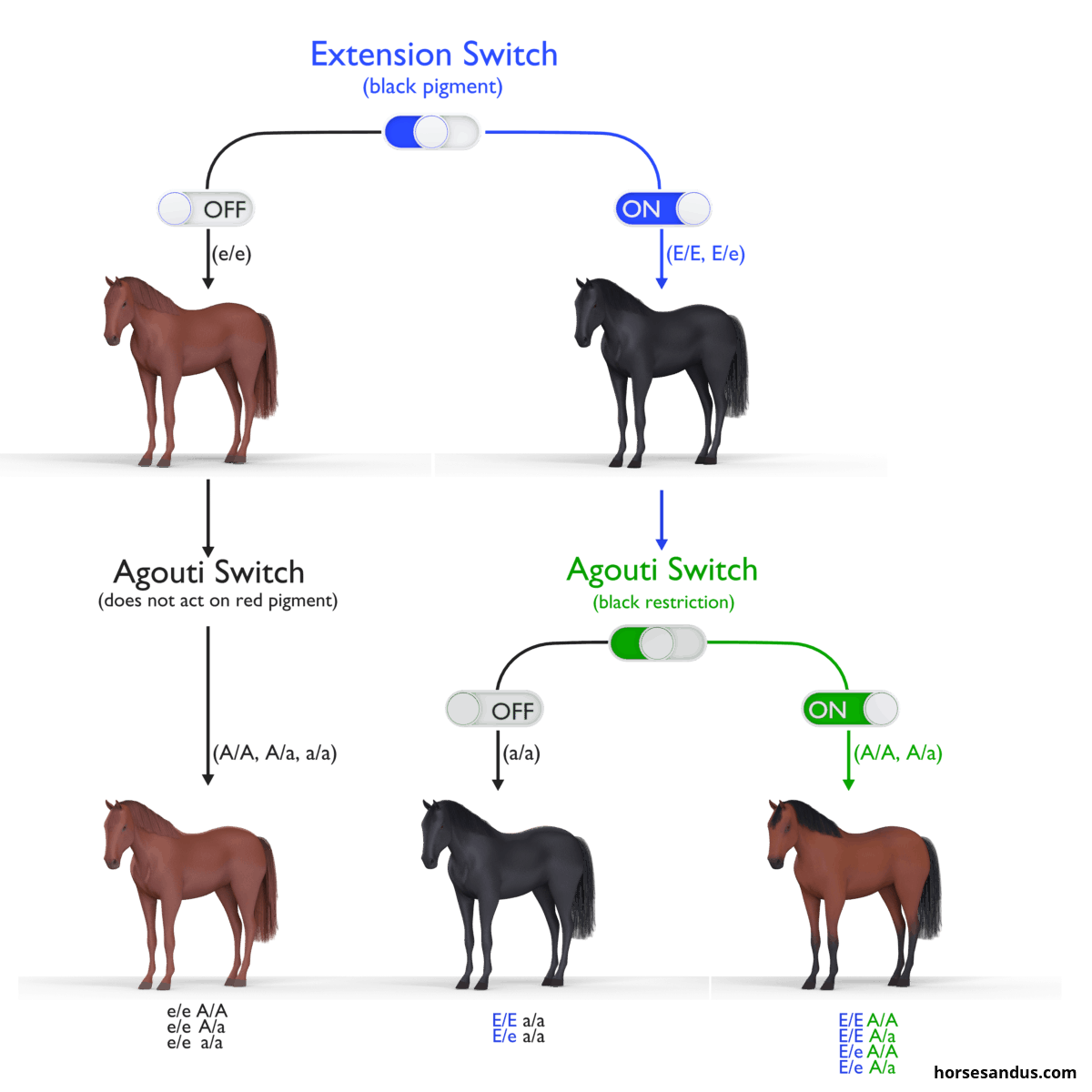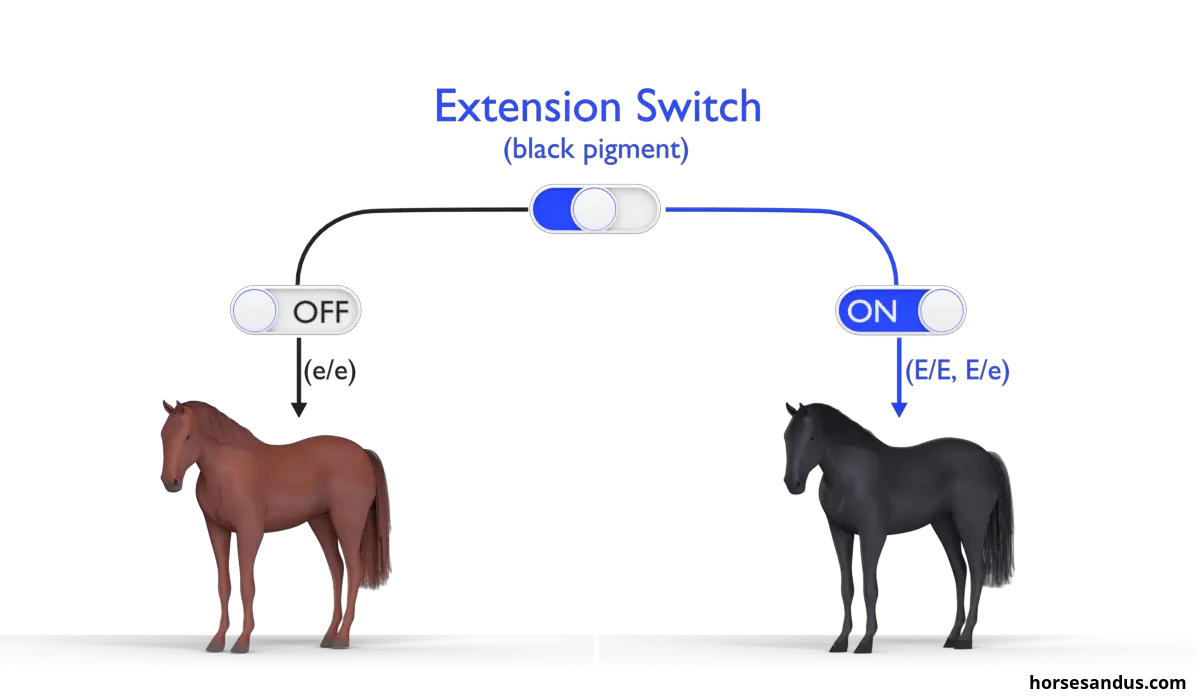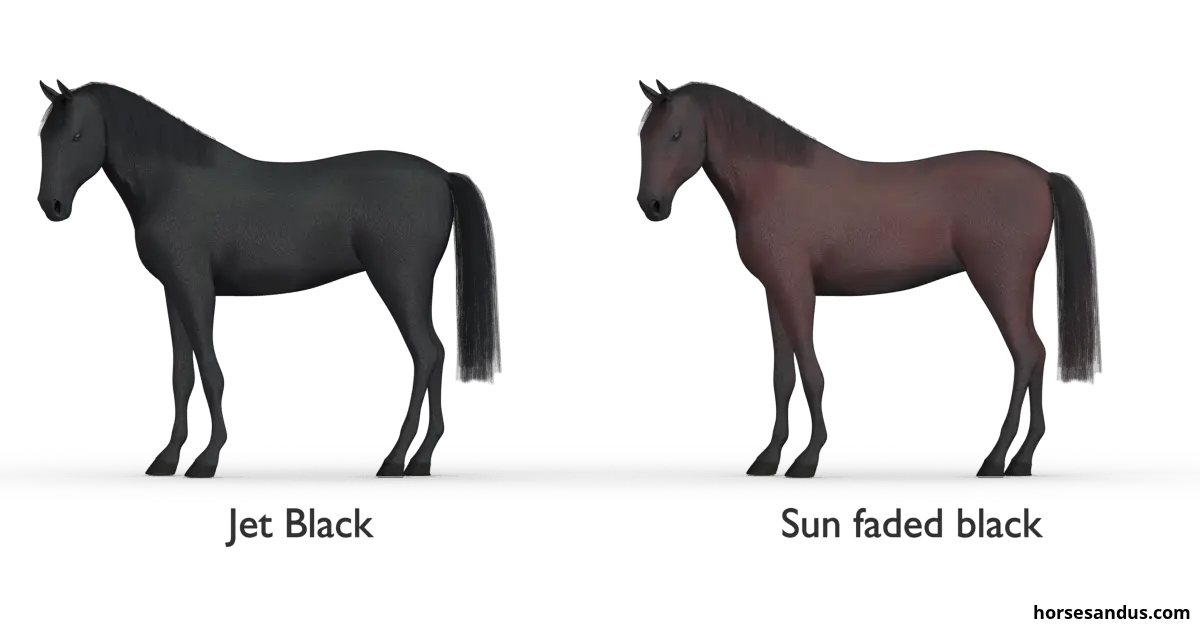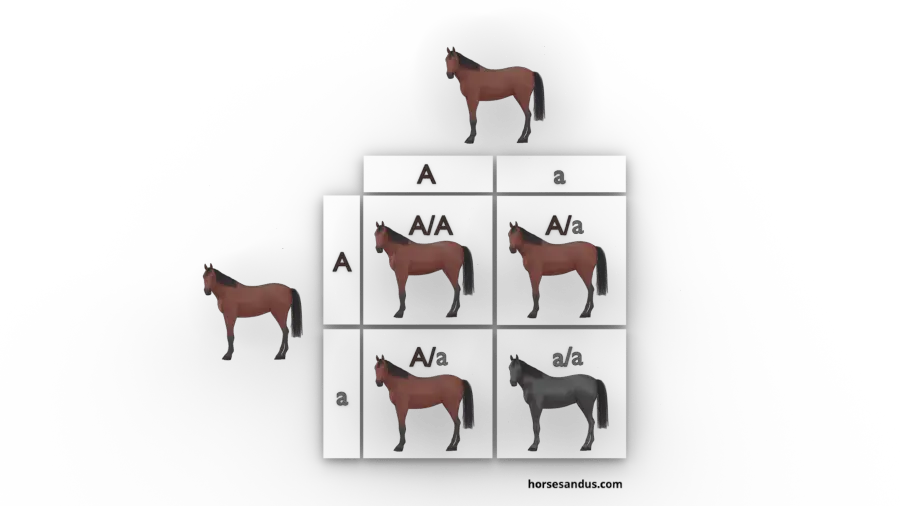The 3 base horse coat colors are Red (chestnut), Black, and Bay. However, horses are only capable of producing 2 pigments: red (Pheomelanin) and black (eumelanin). So with these pigments, they can be either red or black.

So how do we get the third base coat color, bay? To understand how the bay color is produced, you first need to understand the concept of points.
What are the points of the horse ?
The points are the mane, tail, lower part of the limbs, and rim of the ears. For the identification of coat color, it is necessary to understand the concept of points.

These points can be either black or of the same color as the rest of the body. The two main groups of colors are:
- those with black points
- those with non-black points
Every single horse no matter what its color or pattern has one of 3 base coat colors. Then the diversity of colors we see today is due to the action of additional color and pattern genes.
The genes behind the 3 base coat colors
Some knowledge about the basics of horse color genetics is useful for a better understanding of this article.
The 3 base horse coat colors are based on 2 genes: Extension and Agouti.
- The Extension gene (E) is responsible for the color of the pigment, either black or red.
- The Agouti gene (A) is responsible for the distribution of black color to the points (mane, tail, the lower part of the limbs, and rim of the ears).
Together, Extension and Agouti are responsible for the 3 base coat colors of horses:
- Chestnut – Red body with red points
- Black – Black body with black points
- Bay – Red body with black points

Extension gene (E)
Skin cells produce two different pigments: Eumelanin (black pigment) and Pheomelanin (red pigment). The production of these pigments is determined by the Extension gene (E).
The Extension gene has two alleles: E and e. These alleles either extend (E) or reduce (e) the amount of black pigment in the coat.
E allele
- E – dominant allele which enables the production of black pigment in the coat of the horse. It extends the black pigment to the hair and skin.
Because it is dominant, this allele is expressed in both the heterozygous (E/e) and the homozygous state (E/E).
In these cases the horse will display the base color black.
e allele
- e – recessive allele, which enables the production of red pigment in the horse’s hair, although the skin remains black.
Because it is recessive, this allele is only expressed in the homozygous state (e/e). When the E allele is not present, i.e., when E is “switched off.”
In this case the horse will display the base color red (Chestnut).

So the Extension gene is responsible for the horse’s base color (either red or black). All other genes act to modify or mask the effects of the Extension gene.
Agouti gene (A)
The Agouti gene is responsible for the distribution of the black pigment on the coat of the horse.
The effect of this gene is to restrict the black pigment to the points (mane, tail, limbs, and ear rims). The rest of the body will be switched to a red shade.
In other words, the Agouti gene inhibits the action of the Extension gene on the body of the horse, but not on the points.
The Agouti only modifies the black pigment. It does not act on the red pigment. The mechanism behind this is quite obvious – if there is no black pigment to distribute, then a gene determining the distribution of black pigments can have no effect.
The Agouti gene has two alleles: A and a. These alleles either restrict the black to the points (A) or leave the black where it is (a).
A allele
- A – dominant allele which restricts the black pigment to the points.
Because it is dominant, this allele is expressed in both the heterozygous (A/a) and the homozygous state (A/A).
In these cases the horse will display the base color bay
a allele
- a – recessive allele that enables the production of black pigment throughout the entire coat.
Because it is recessive, this allele is only expressed in the homozygous state (a/a), i.e., when the A allele is not present or, in other words, when A is “switched off.”
In this case the horse will display the base color black.

So in summary:
- Bay horses have both Extension and Agouti turned on
- Black horses have Extension turned on but not Agouti
- Chestnut horses have Extension turned off and are indifferent to Agouti
Together, Extension and Agouti are responsible for the three base colors of horses, namely, black, bay, and chestnut (red).
How the 3 base colors are produced (Animation)
All other equine coat colors and patterns stem from these base coat colors. They are obtained through the action of genes that produce dilutions, patterns, and depigmentation.
Red Horse (chestnut)
Chestnut horses have a reddish to brown color coat, with an absolute absence of black hairs.
The mane and tail are the same color as the body or lighter (flaxen). They have dark brown eyes and black skin.
The Different shades of Chestnut Horses
The chestnut has a wide range of shades. Some chestnut horses have very light, red coats, while others exhibit a much darker coloration.
The Extension gene is not responsible for this type of shade variation. Other genetic controls are likely responsible for the variation in intensity but are not yet well understood.
Collectively all these colors are called “red,” but different terms are used to describe these shades.
The shades and terms below are only examples. Other terms can be used, and also the range of shades is not limited to the three in the picture below. This is just to give an idea about how extreme the variation can be.

Light Chestnut or Sandy Chestnut
Is a very pale red tending towards a yellow shade. Sandy chestnut can be mistaken for a palomino when the mane and tail are blonde due to the presence of the flaxen gene.
Red Chestnut or Sorrel
This is the most common chestnut shade and ranges from a toned-down copper color to a more bold red.
Liver or Black chestnut
This is the least common of the chestnut shades and is a very dark-reddish brown. Sometimes it is simply called brown.
Some red horses are so dark that they appear black and are often called “black chestnuts.” They may be almost indistinguishable from true black.
The Flaxen Trait of Chestnut Horses
Chestnut horses of any shade may present the flaxen trait. This trait is characterized by the mane and tail being noticeably lighter than the body coat color, often a blonde shade.
Certain horse breeds such as the Haflinger always carry the flaxen chestnut coloration.
The flaxen trait is probably caused by a genetic mechanism that affects the red pigment produced in chestnut horses. But it does not affect the black pigment existing in black and bay horses.
The effect of flaxen on the three main shades of chestnut is shown in the image.

Are Chestnut Horses Crazy ?
Rumors say chestnut horses are “crazy.” Yet, no evidence was ever found to support this belief. But an interesting discovery was made. Chestnut horses tend to be bolder, interacting more easily with unfamiliar things in the environment, and resisting more forceful training methods. That can be why they are labeled as difficult or “crazy.”
Genes influencing color can also influence behavior
Scientific studies have analyzed the belief that chestnut horses are crazy. It is known that mutations in the genes influencing melanocytes (cells that produce melanin) not only affect the color of an animal but also impact physiological and behavioral functions. So the relationship between color and certain behaviors seemed plausible.
You can find an interesting article about this here: The MC1R and ASIP Coat Color Loci May Impact Behavior in the Horse.
Chestnut color did not exist before domestication
The chestnut color did not exist in the primitive horse. It is a result of the selection made by man after domestication. So possibly, the selection for chestnut color may have involved a selection accidentally for boldness as well.
Chestnut Horse Genes inheritance
The production of a red coat is only possible when the dominant allele E of the Extension gene is switched off. In other words, when the horse has only the recessive allele e present: e/e
So as we can see in the Punnett square, the mating of two red horses can only produce red foals.

How long has chestnut horse color been around ?
The earliest chestnut allele e was identified in a Romanian fossil sample from 7000 years ago. But chestnut horses ( homozygous e/e) were only observed in fossils from 5000 years ago.
Even though this seems like a long time ago, we know that the chestnut is the most recent of the 3 base colors in the history of the horse and only appeared after domestication.
Horse Breeds That Can Have Chestnut Color ?
Chestnut is a very common color and can be seen in almost every breed of horse. Some breeds, such as the Suffolk Punch and Haflinger, have exclusively chestnut horses.
Black Horse
On a black horse, the entire hair coat is black, including the mane and tail. There are no brown, red, or lighter colors on a real black horse. True black horses have dark brown eyes and black skin.
The different shades of black Horses
Genetically black horses can show a graded variation in color. This variation can cause some black horses to appear brown.
Black horses can come in two variations: fading and non-fading.

Some black horses are of the fading type and lose the jet black color due to sunlight exposure. They may resemble dark bay horses, but genetically they are the same as rich black horses.
A visible difference between a true black and a dark chestnut or bay is seen in the hairs around the eyes and muzzle. These hairs are black on a true black horse, even if it is sun-bleached. In other colors, these hairs will be lighter.
Black Foal Color
Most black foals are usually born with a mousy grey color. But as their foal coat begins to shed out, their black color will show through.
However, in some breeds black foals are already born with the jet black color.

Genes Inheritance
Using the Punnett square, we can see the possible outcomes for foals with two black coat parents.
Note that in this example, we are just considering the Extension gene. With other layers of genes, the results may differ, as we will see in other articles of this series.





How Long Has Horse black Color Been Around?
Black is one of the oldest colors in horses and was depicted in prehistoric cave paintings. The black genotype (E/E or E/e) was first identified in an Iberian horse’s fossils from the Early Holocene epoch, approximately 7000 years ago.
Horse Breeds That Can Have The Black Color ?
Black is a relatively uncommon color, although it can be found in many breeds. Some breeds like Friesen and Murgese are almost only black.
Bay Horse
Bay is a horse coat color, characterized by a red body and black points (mane, tail, ear edges, and lower legs).
The shades of bay
The red color of the body may have different shades similar to the chestnut horse.
Collectively all these colors are called “bay,” but different terms are used to describe these shades.
As mentioned earlier, the shades and terms below are only examples. Other shades and terms exist.

Sandy Bay
Has a very light red body tending towards a yellow shade. Sandy Bay can be mistaken for a buckskin.
Standard Bay
This is the most common shade of bay and ranges from a toned-down copper color to a more bold red.
Dark Bay
This is a dark-reddish brown, almost black. Dark bay horses can be mistaken for sun-faded black horses.
Wild Type Bay Horse
The wild-type bay carries a different version of the Agouti gene, represented by A+.
In the wild-type bay, the black on the legs is much less extended than on the standard bay. The black is always below the hock and the knee. It is mostly restricted to the fetlock joints and pasterns.
Wild-type bays are fairly uncommon.

Genes inheritance
The bay horses result from the interaction of two genes: Extension gene and Agouti gene.
The Agouti gene acts upon the Extension gene by limiting the black color to the points (mane, tail, lower limbs, and ear rims).
Considering all possible combinations of these two genes which are present in a bay horse, the outcome from the mating of two bay horses will be predominantly a bay horse.
To predict the outcome of two bay horses we will use the following Punnett squares.



We must also not forget that chestnut horses may carry the Agouti gene A, which will be masked because this gene does not act upon red pigment. So bay horses may result when such chestnuts are mated with a black horse.
The following Punnett squares show how this can be possible.


How Long Has Bay Horse Color Been Around ?
Bay is one of the oldest colors in horses and was depicted in prehistoric cave paintings from approximately 25 000 years ago. DNA analysis of horse fossils from the late Pleistocene epoch identified the bay gene.
Horse Breeds That Can Have The Bay Color?
Bay is one of the most common coat colors and is present in many horse breeds. Furthermore, the Cleveland bay breed has only bay horses.
Futher Reading
If you would like to learn more about horse colors and white patterns, you may want to read the following books, available on amazon.
The links below that lead to products on Amazon are affiliate links and I earn a commission (with no additional cost for you) if you make a purchase.
The following books are an introduction to horse colors and white patterns which are full of images and very easy to understand.
The Equine Tapestry: An Introduction to Colors and Patterns The Ultimate Guide to Horse ColorsA more technical book about horse colors, but still very easy to understand.
Equine Color Genetics

